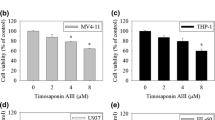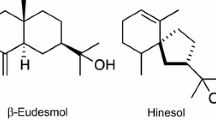Summary
RM, a novel aminosteroid synthesized by our research group, shows a broad spectrum of antitumor activity against nine cancer cell lines and limited toxicity against two normal cell lines. However, its related mechanism of action has not yet been elucidated. In this study, we investigated the cellular and molecular events underlying the cytotoxicity of RM in human acute promyelocytic leukemia HL-60 cells. RM was found to induce a G0/G1 cell cycle block of HL-60 cells but not terminal myeloid differentiation. Interestingly, typical apoptotic morphological changes were exhibited by HL-60 cells treated with RM stained with Hoechst 33342 and examined by fluorescence microscopy. Apoptotic death assay using annexin-V/propidium iodide dual staining flow cytometry demonstrated a dose-dependent apoptotic effect of RM on HL-60 cells. In addition, RM induced the cleavage of caspase-3, caspase-8 and PARP, but not the cleavage of caspase-9. Our findings suggest that RM reduces HL-60 cells survival through a caspase-dependent death receptor pathway.









Similar content being viewed by others
References
Casanova I, Bosch R, Lasa A, Parreño M, Mangues R (2008) A celecoxib derivative inhibits focal adhesion signaling and induces caspase-8-dependent apoptosis in human acute myeloid leukemia cells. Int J Cancer 123:217–226
Bremer E, van Dam G, Kroesen BJ, de Leij L, Helfrich W (2006) Targeted induction of apoptosis for cancer therapy: current progress and prospects. Trends Mol Med 12:382–393
Murata T, Itoigawa M, Ito C, Nakao K, Tsuboi M, Kaneda N, Furukawa H (2008) Induction of apoptosis in human leukaemia HL-60 cells by furanone-coumarins from Murraya siamensis. J Pharm Pharmacol 60:385–389
Chowdhury I, Tharakan B, Bhat GK (2008) Caspases—an update. Comp Biochem Physiol B Biochem Mol Biol 151:10–27
He Q, Jiang D (1999) A novel aminosteroid is active for proliferation inhibition and differentiation induction of human acute myeloid leukemia HL-60 cells. Leukemia 23:369–372
Roy J, DeRoy P, Poirier D (2007) 2beta-(N-substituted piperazino)-5alpha-androstane-3alpha, 17beta-diols: parallel solid-phase synthesis and antiproliferative activity on human leukemia HL-60 cells. J Comb Chem 9:347–358
Roy J, Maltais R, Jegham H, Poirier D (2010) Libraries of 2β-(N-substituted piperazino)-5α-androstane-3α,17β-diols: chemical synthesis and cytotoxic effects on human leukemia HL-60 cells and on normal lymphocytes. Mol Div 14 (in press). doi:10.1007/s11030-010-9273-2
Thibeault D, Roy J, DeRoy P, Poirier D (2008) Chemical synthesis of 2beta-amino-5alpha-androstane-3alpha, 17beta-diol N-derivatives and their antiproliferative effect on HL-60 human leukemia cells. Bioorg Med Chem 16:5062–5077
Park BY, Oh SR, Ahn KS, Kwon OK, Lee HK (2008) (−)-Syringaresinol inhibits proliferation of human promyelocytic HL-60 leukemia cells via G1 arrest and apoptosis. Int Immunopharmacol 8:967–973
Bezerra DP, Militão GC, de Castro FO, Pessoa C, de Moraes MO, Costa-Lotufo LV (2007) Piplartine induces inhibition of leukemia cell proliferation triggering both apoptosis and necrosis pathways. Toxicol In Vitro 21:1–8
Pozarowski P, Grabarek J, Darzynkiewicz Z (2004) Flow cytometry of apoptosis. Curr Protoc Cell Biol 18:Unit 18.8
Sapan CV, Lundblad RL, Price NC (1999) Colorimetric protein assay techniques. Biotechnol Appl Biochem 29(Pt 2):99–108
St-Laurent JF, Gagnon SN, Dequen F, Hardy I, Desnoyers S (2007) Altered DNA damage response in Caenorhabditis elegans with impaired poly(ADP-ribose) glycohydrolases genes expression. DNA Repair 6:329–343
Kramer CY (1956) Extension of multiple range tests to group with unique numbers of replications. Biometrics 12:307–310
Kuo HC, Kuo WH, Lee YJ, Wang CJ, Tseng TH (2006) Enhancement of caffeic acid phenethyl ester on all-trans retinoic acid-induced differentiation in human leukemia HL-60 cells. Toxicol Appl Pharmacol 216:80–88
Tsolmon S, Kurita Y, Yamada P, Shigemori H, Isoda H (2009) Indoleacetic acid falcarindiol ester induces granulocytic differentiation of the human leukemia cell line HL-60. Planta Med 75:49–54
Luo LY, Zhang TL, Wang K (2006) Differentiation of HL-60 cells induced by realgar nano-particles. China J Chin Mat Med 31:1343–1346 (Chinese)
Brackman D, Lund-Johansen F, Aarskog D (1995) Expression of cell surface antigens during the differentiation of HL-60 cells induced by 1, 25-dihydroxyvitamin D3, retinoic acid and DMSO. Leukemia Res 19:57–64
Heinrich MC, Scheer M, Heckmann M, Kuefner MA, Uder M (2009) Iodixanol induces apoptotic and antiproliferative effects but no necrotic cell death in renal proximal tubular cells in vitro. Rofo 181:349–354
Garner DL (2009) Hoechst 33342: the dye that enabled differentiation of living X-and Y-chromosome bearing mammalian sperm. Theriogenology 71:11–21
Park H, Aiyar SE, Fan P, Wang J, Yue W, Santen RJ (2007) Effects of tetramethoxystilbene on hormone-resistant breast cancer cells: biological and biochemical mechanisms of action. Cancer Res 67:5717–5726
Baldwin EL, Osheroff N (2005) Etoposide, topoisomerase II and cancer. Curr Med Chem Anticancer Agents 5:363–372
Montecucco A, Biamonti G (2007) Cellular response to etoposide treatment. Cancer Lett 252:9–18
Vermeulen K, Van Bockstaele DR, Berneman ZN (2005) Apoptosis: mechanisms and relevance in cancer. Ann Hematol 84:627–639
Kim YH, Shin KJ, Lee TG, Kim E, Lee MS, Ryu SH, Suh PG (2005) G2 arrest and apoptosis by 2-amino-N-quinoline-8-yl-benzenesulfonamide (QBS), a novel cytotoxic compound. Biochem Pharmacol 69:1333–1341
Lee KW, Kim HJ, Lee YS, Park HJ, Choi JW, Ha J, Lee KT (2007) Acteoside inhibits human promyelocytic HL-60 leukemia cell proliferation via inducing cell cycle arrest at G0/G1 phase and differentiation into monocyte. Carcinogenesis 28:1928–1936
Wang KR, Yan JX, Zhang BZ, Song JJ, Jia PF, Wang R (2009) Novel mode of action of polybia-MPI, a novel antimicrobial peptide, in multi-drug resistant leukemic cells. Cancer Lett 278:65–72
Terui Y, Furukawa Y, Kikuchi J, Saito M (1995) Apoptosis during HL-60 cell differentiation is closely related to a G0/G1 cell cycle arrest. J Cell Physiol 164:74–84
Ji J, Zhang L, Wu YY, Zhu XY, Lv SQ, Sun XZ (2006) Induction of apoptosis by d-limonene is mediated by a caspase-dependent mitochondrial death pathway in human leukemia cells. Leuk Lymphoma 47:2617–2624
Hsu CL, Yu YS, Yen GC (2008) Lucidenic acid B induces apoptosis in human leukemia cells via a mitochondria-mediated pathway. J Agric Food Chem 56:3973–3980
Liu J, Hu WX, He LF, Ye M, Li Y (2004) Effects of lycorine on HL-60 cells via arresting cell cycle and inducing apoptosis. FEBS Lett 578:245–250
Vrba J, Dolezel P, Vicar J, Modriansky M, Ulrichova J (2008) Chelerythrine and dihydrochelerythrine induce G1 phase arrest and bimodal cell death in human leukemia HL-60 cells. Toxicol In Vitro 22:1008–1017
Petak I, Houghton JA (2001) Shared pathways: death receptors and cytotoxic drugs in cancer therapy. Pathol Oncol Res 7:95–106
Hyer ML, Shi R, Krajewska M, Meyer C, Lebedeva IV, Fisher PB, Reed JC (2008) Apoptotic activity and mechanism of 2-cyano-3, 12-dioxoolean-1, 9-dien-28-oic-acid and related synthetic triterpenoids in prostate cancer. Cancer Res 68:2927–2933
Acknowledgments
This work was supported by the Canadian Institutes of Health Research (CIHR) and the Canadian Cancer Research Society (CRS). The authors would like to thank Dr. Charles Doillon, Dr. Fawzi Aoudjit, Dr. Maurice Dufour and Jean-François St-Laurent for their technical assistance and their helpful discussions. Careful reading of the manuscript by Mrs. Micheline Harvey is also greatly appreciated.
Author information
Authors and Affiliations
Corresponding author
Rights and permissions
About this article
Cite this article
Jegham, H., Roy, J., Maltais, R. et al. A novel aminosteroid of the 5α-androstane-3α,17β-diol family induces cell cycle arrest and apoptosis in human promyelocytic leukemia HL-60 cells. Invest New Drugs 30, 176–185 (2012). https://doi.org/10.1007/s10637-010-9548-6
Received:
Accepted:
Published:
Issue Date:
DOI: https://doi.org/10.1007/s10637-010-9548-6




